Exam 2 BIOL 223 Membrane Potential
1/91
There's no tags or description
Looks like no tags are added yet.
Name | Mastery | Learn | Test | Matching | Spaced |
|---|
No study sessions yet.
92 Terms
The plasma membrane separates the cell from its surrounding environment and performs various functions. What does it do regarding concentration?
The cell membrane allows the inside concentration of electrolytes and other solutes to be different from extraceullular concentration of solutes.
Inside = cytosol = (intracellular or interstital)?
intracellular
Outside = extracellular = (intracellular or interstital)?
Interstitial
What is important to excite cell membranes?
Ion flow
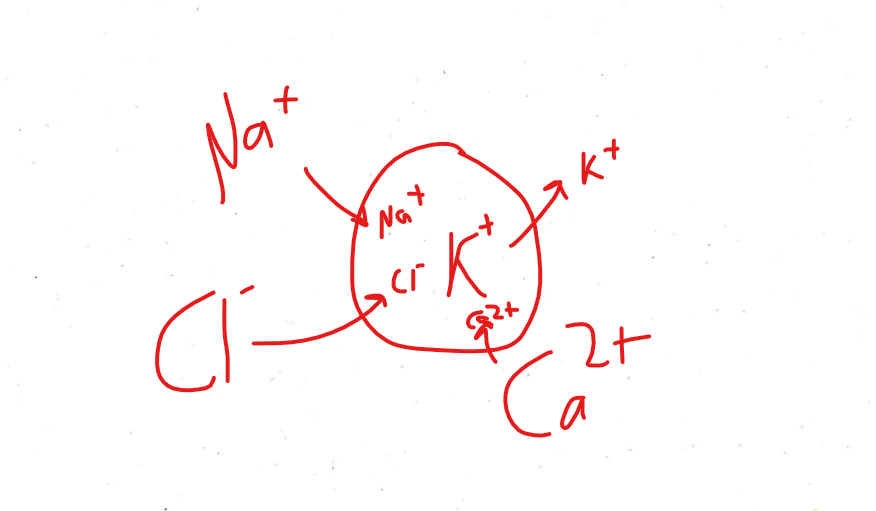
What are the big 4 ions in the cell?
Na+, K+, Cl-, Ca2+
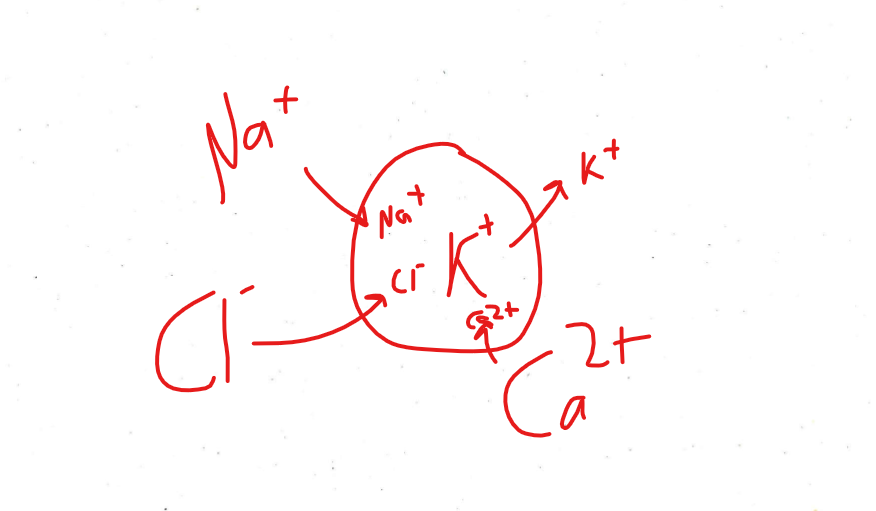
What ions are in higher concentration inside the cell? What ions are in higher concentration outside the cell?
Higher inside: K+, proteins (negatively charged)
Higher outside: Na+, Cl-, Ca2+
How does one go against a concentration gradient?
Use ATP
What is the difference between passive & active transport?
Passive transport: No ATP. Does not expend energy
Active transport: ATP is used, expends energy.
What is the movement from a high concentration → low concentration called?
Diffusion
What is Diffusion?
movement from a high concentration → low concentration
T/F: Molecules with no electrical charges diffuse down or along the chemical concentration gradient of the molecule.
T
For charged ions & molecules, they diffuse based on what gradient?
Electrochemical gradient.
The chemical concentration gradient is 1 driving force
The electrical concentration gradient is another driving force.
T/F: The inside of our cells is negatively charged overall.
T
T/F: The inside of our cells is positively charged overall.
F, it is negatively charged
O2 from lungs to blood → interstitial spaces → into cells → into mitochondria
CO2 moves from cells into interstitial spaces → into blood → out through lungs
Water moves across epithelium of digestive tract
are examples of
diffusion in body fluids
T/F: A membrane must be permeable for diffusion to occur.
T
T/F: A membrane does not have to be permeable for diffusion to occur.
F. It must be permeable.
What is the lipid bilayer permeable to? What is it NOT permeable to?
Permeable to O2, CO2, and most hydrophobic molecules like lipids (the O2 makes sense because we need O2 in and CO2 out)
NOT permeable for most large molecules & most hydrophilic molecules
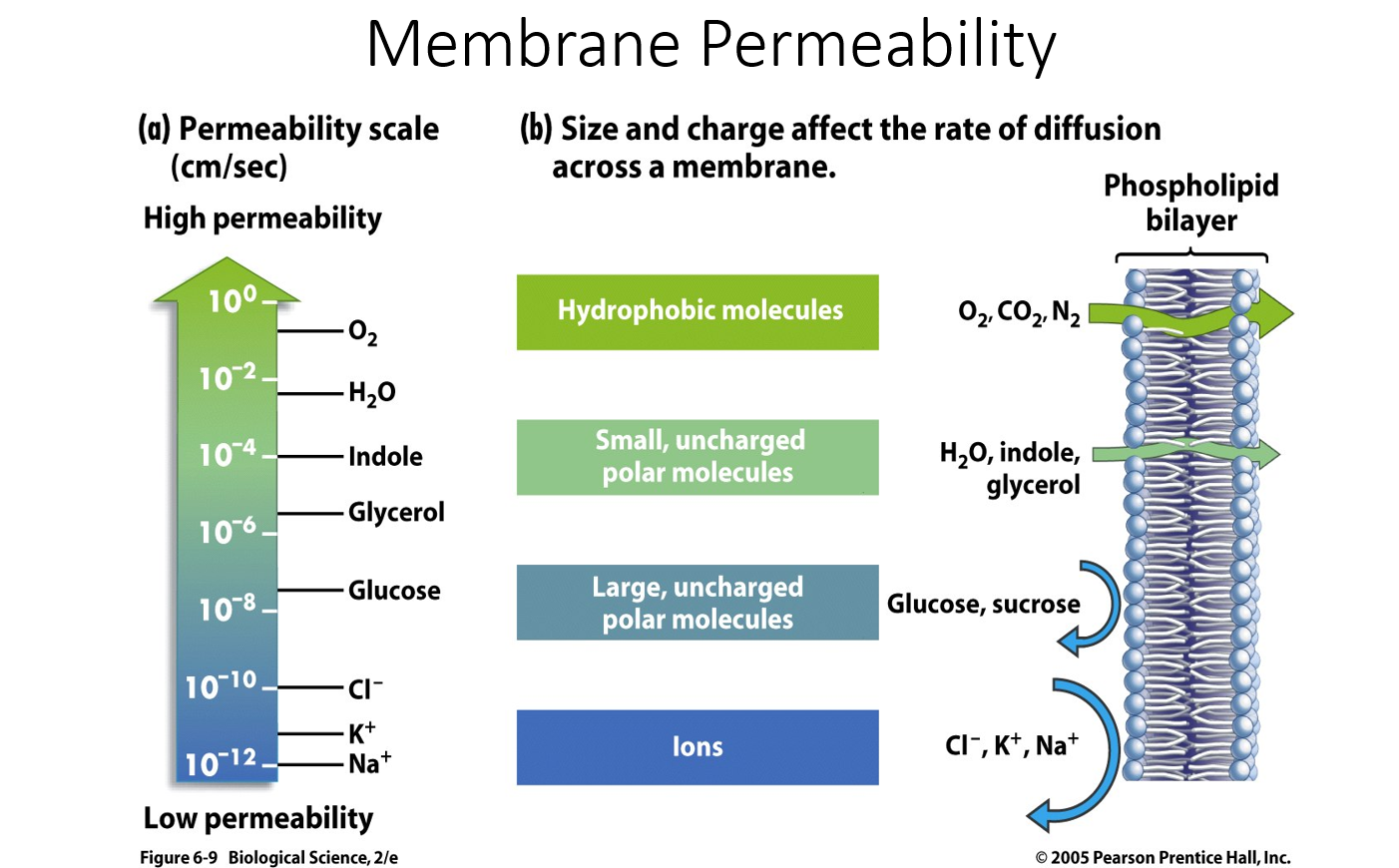
How would glucose & sucrose diffuse through the phospholipid bilayer?
They wouldn’t, because they are large, uncharged, polar molecules.
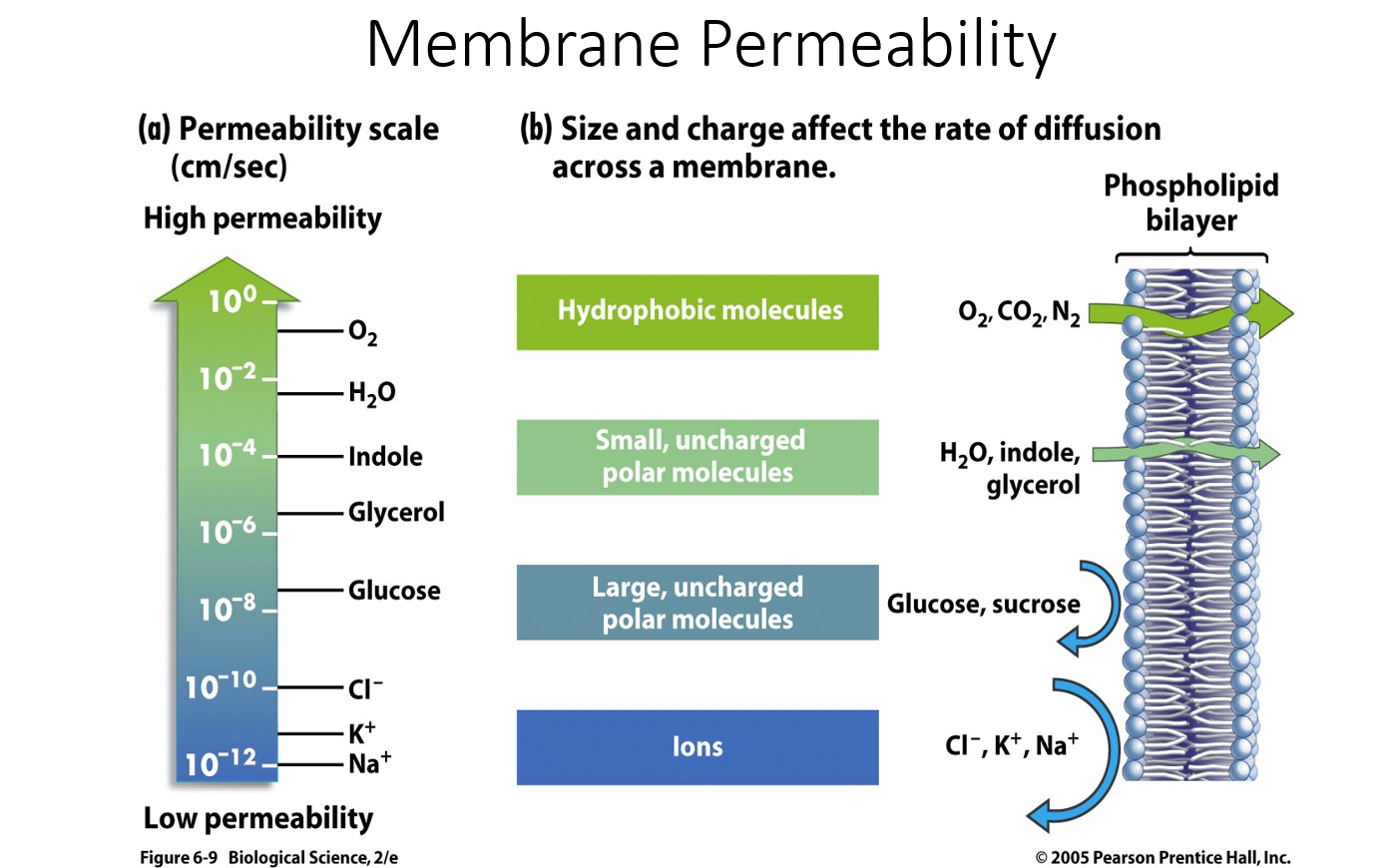
How would hydrophobic molecules diffuse through the phospholipid bilayer?
They diffuse easily into the bilayer (O2, CO2, N2)
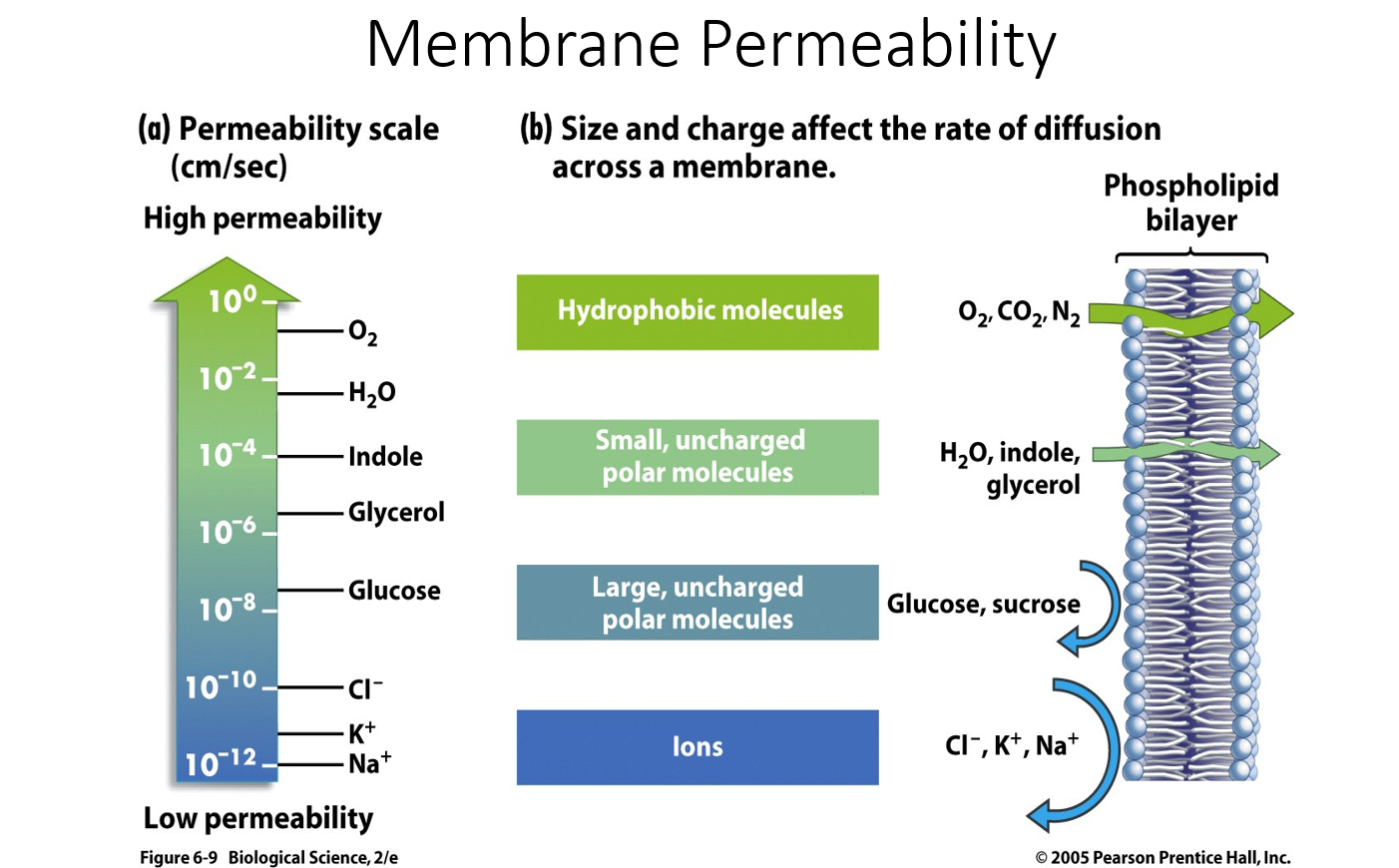
How would large, uncharged polar molecules diffuse through the phospholipid bilayer?
They wouldn’t, because of their size and charge (Ex. glucose and sucrose)
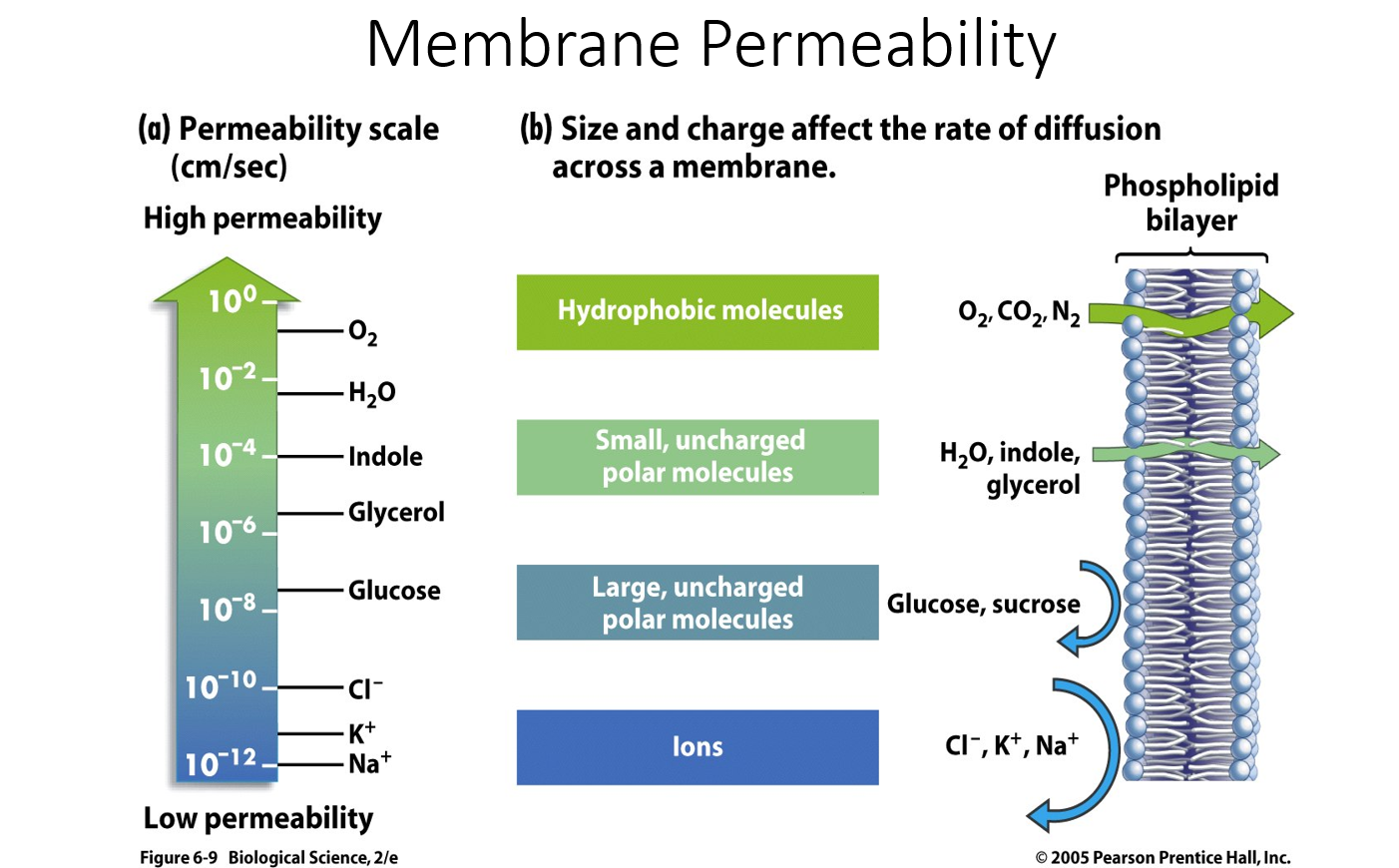
How would Cl-, K+, and Na+ diffuse through the phospholipid bilayer?
They wouldn’t, due to their charge (they are ions)
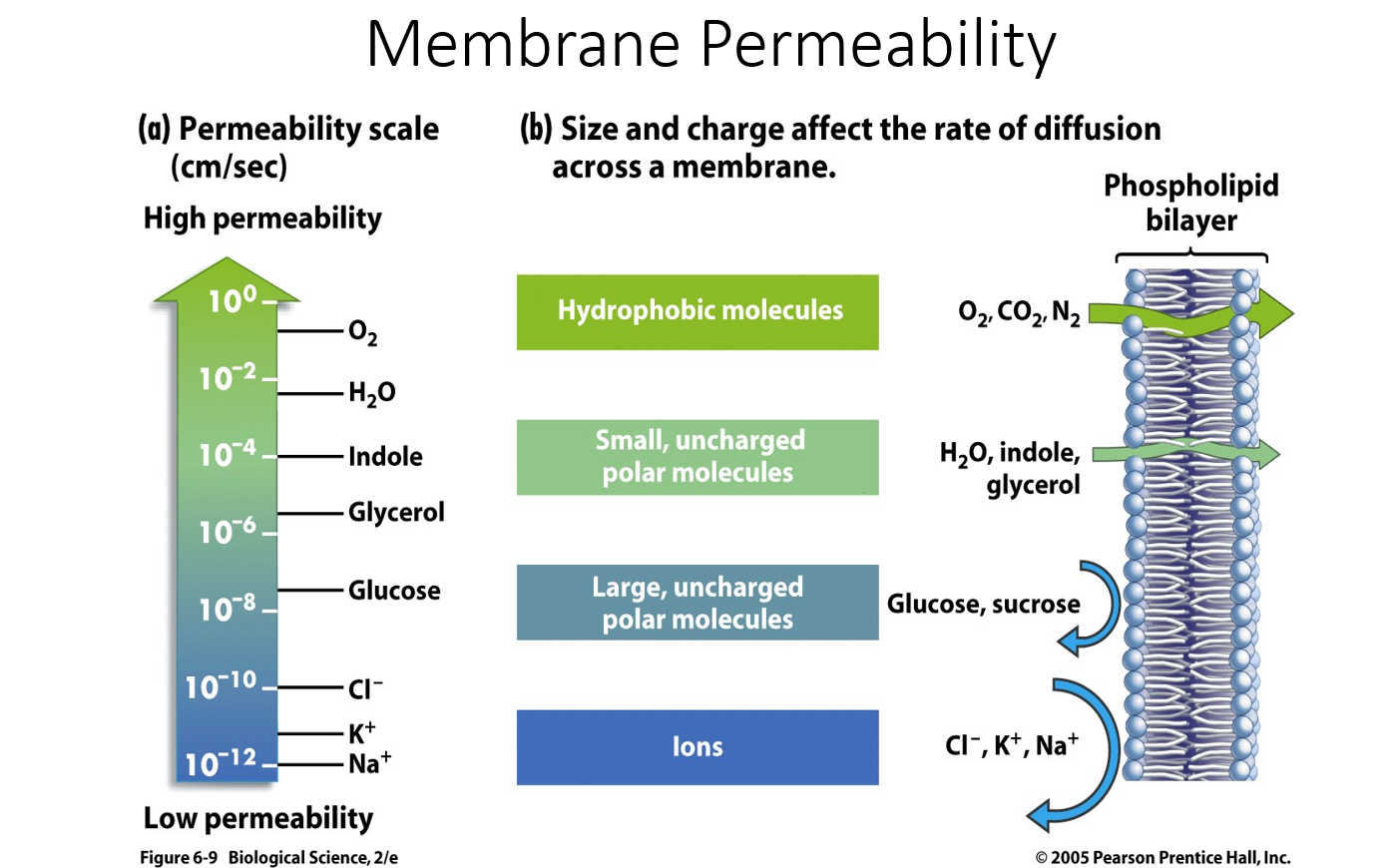
How would ions diffuse through the phospholipid bilayer?
They would not pass through due to their charge (ex. Cl-, K+, Na+)
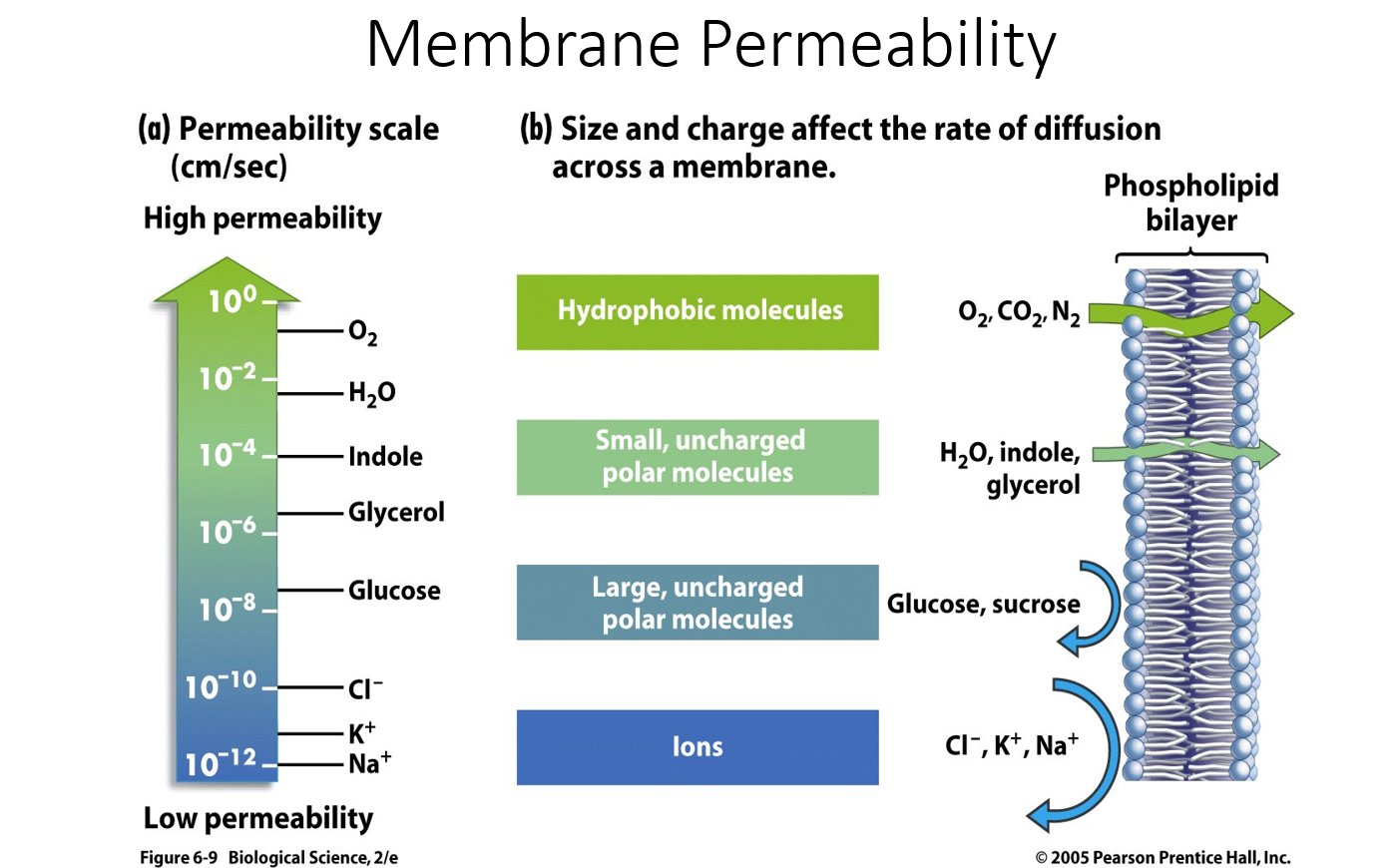
How would small, uncharged polar molecules diffuse through the phospholipid bilayer?
They would diffuse easily because they are small and uncharged
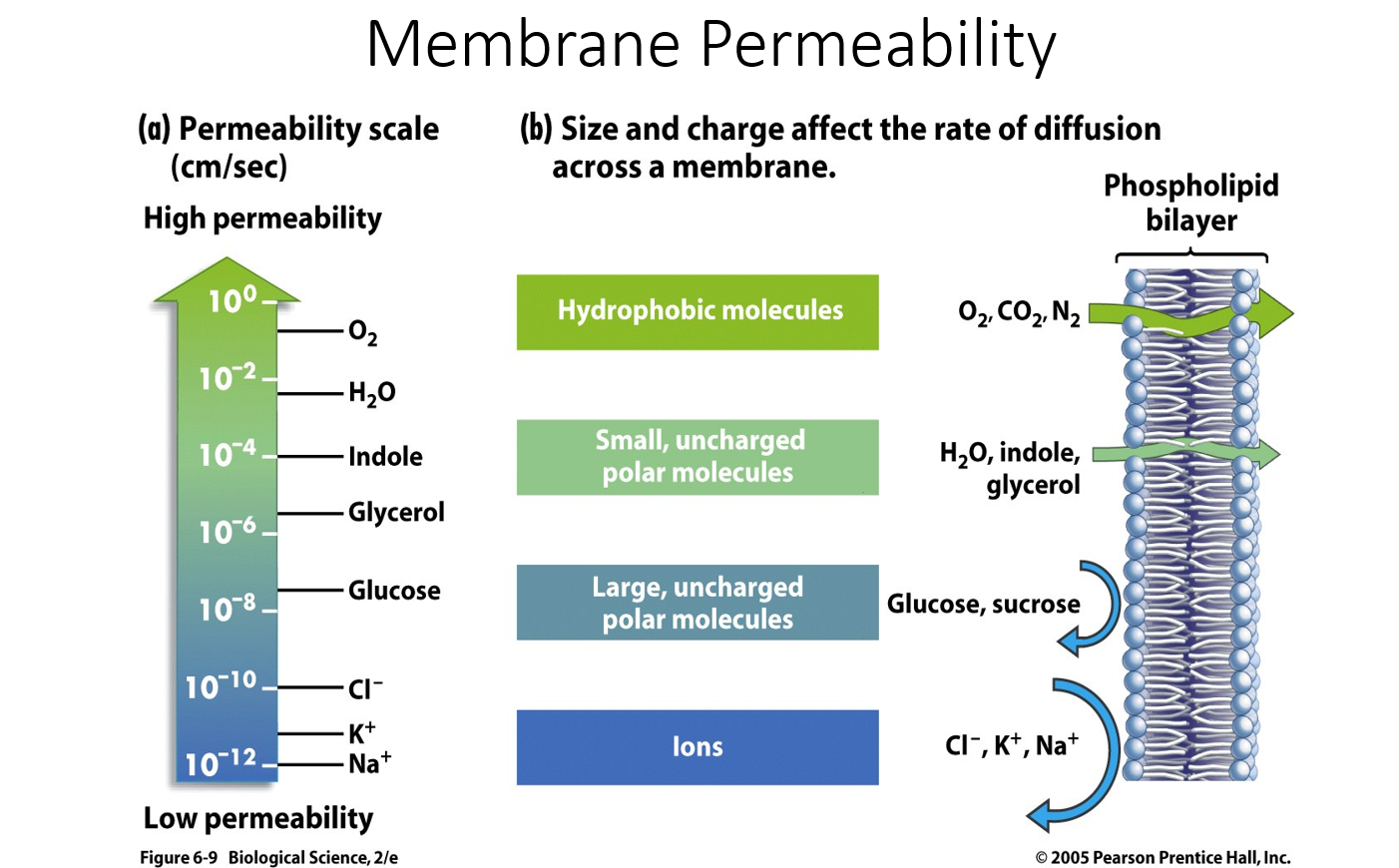
What affects the rate of diffusion across a membrane?
size and charge
What is osmosis?
The diffusion of water across a semi-permeable membrane in response to solute differences
Concentration of water is related to total concentration of all solutes (dissolved materials) including ions, proteins, monomers, polymers, etc.
Does water move by diffusion (up/down) its concentration gradient?
Water moves down its concentration gradient.
Does water move down or up its concentration gradient? (Hint: unlike diffusion, which moves high conc to low conc)
Down
Why does sodium move into the cell?
Because there is a high concentration of sodium outside the cell, and there is a low concentration of Na+ inside the cell. Diffusion is the movement from a high concentration → low concentration.
T/F: Water tends to diffuse across a membrane toward a solution containing the higher solute concentration.
T
T/F: Water tends to diffuse across a membrane toward a solution containing the lower solute concentration.
F. Water tends to diffuse across a membrane toward a solution containing the higher solute concentration. This is the case for how water diffuses specifically (called OSMOSIS).
What is osmotic pressure?
Osmotic pressure = force of water movement into a solution.
What is tonicity?
The effects of extracellular solutions on cells.
What does it mean for a cell to be isotonic?
No net osmosis, no net gain or loss of water
What does it mean for a cell to be hypertonic? What can it result in?
Net water flow out of cell (can result in crenation—shrivel)
What does it mean for a cell to be hypotonic? What can it result in?
Net gain of water into the cell (can result in cytolysis, hemolysis in RBCs)
T/F: In a hypotonic solution, the swelling may cause the plasma membrane to rupture or lyse.
T
T/F: In a hypotonic solution, the swelling may cause the plasma membrane to crenate (shrivel).
F, this is only true for a hypertonic solution
T/F: In a hypertonic solution, the swelling may cause the plasma membrane to crenate (shrivel).
T
T/F: In a hypertonic solution, the swelling may cause the plasma membrane to rupture or lyse.
F, this is only true for a hypotonic solution.
What are the factors that influence the speed of diffusion? (Diffusion is faster if?)
Molecule is smaller
Temperature is higher (warmer environment)
Concentration gradient is higher (more dramatic concentration gradient)
How does distance influence diffusion?
Concentration gradients are effective ONLY over SHORT distances. Few cells are more than 125 micrometers from a blood vessel.
T/F: Concentration gradients are effective ONLY over SHORT distances.
T. Few cells are more than 125 micrometers from a blood vessel.
T/F: Concentration gradients are effective ONLY over LONG distances.
F. Few cells are more than 125 micrometers from a blood vessel; therefore, concentration gradients are effective ONLY over SHORT distances.
For charged ions, concentration gradient is one driving force, but what is another driving force?
electrical gradient
What would happen if the cell became suddenly permeable to Na+ ions?
Water would move into the cell
Is diffusion an active (energy required) or passive (no energy required) process?
Passive process
The random motion of substances down their chemical or electrical conc gradient is known as
diffusion
Is carrier-mediated transport passive or active? What does it require?
Trick question, it can be passive OR active
Requires a transport protein in membrane
What is carrier mediated transport?
When membrane proteins bind and transport specific molecules or ions
In the context of carrier-mediated transport, what is specificity?
Specificity: Carrier proteins are generally specific for a particular substance.
In the context of carrier-mediated transport, what are saturation limits?
Saturation limits: Rate of transport is subject to the number of transport proteins available. They can only go so fast. Maximum rate of transport of protein.
In the context of carrier-mediated transport, what is regulation?
Regulation: Various control factors exist that affect the activity of carrier proteins. They have the ability to turn on/off and can change carrier proteins overtime.
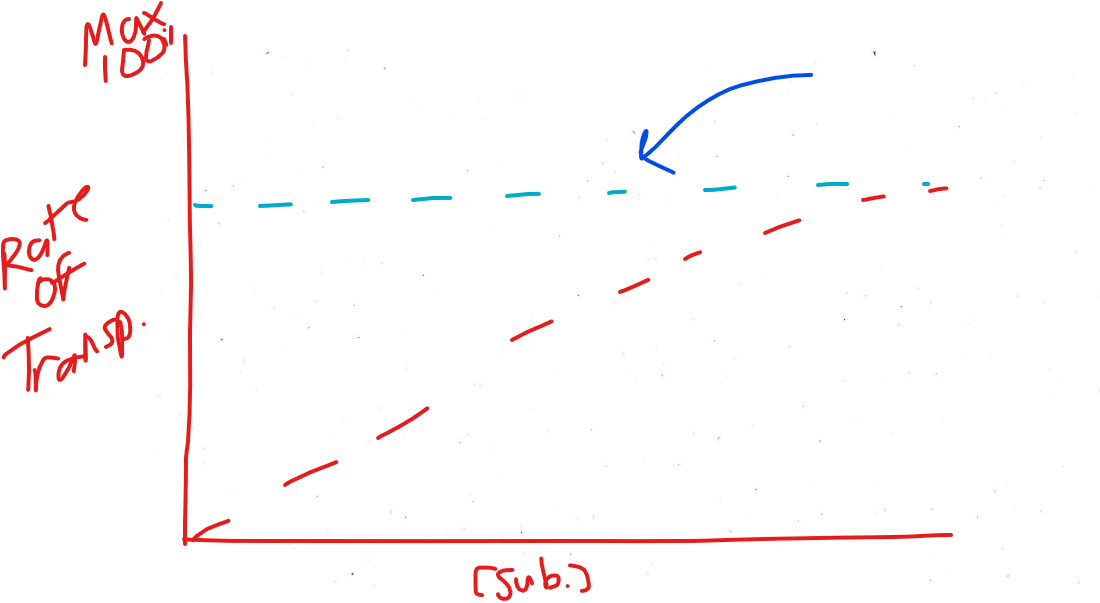
What is the blue line representing?
In carrier-mediated transport, the saturation limit is the maximum rate at which a cell can transport a substance. This occurs when all available carrier proteins are already occupied and working at their maximum capacity.
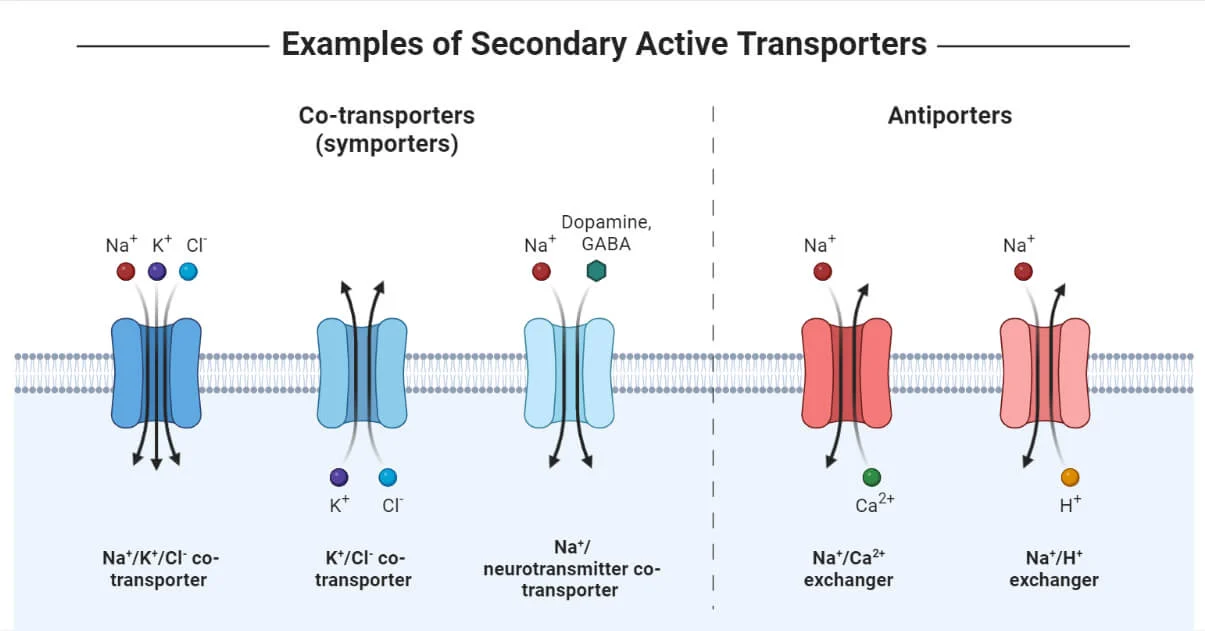
Many carrier proteins transport 1 substance one way only, while some carrier proteins transport 2 substances at the same time. What are the 2 types of transport then called?
Cotransport: both go same directions across membrane.
Counter-transport: go opposite directions across membrane.
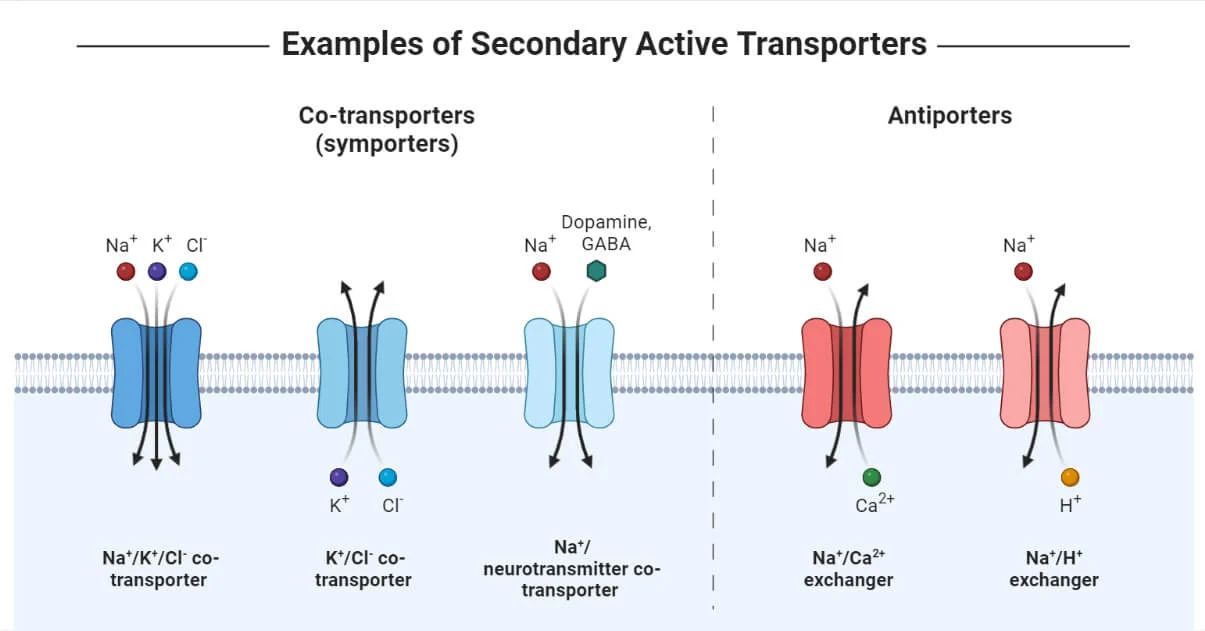
In the context of carrier mediated transport, what is cotransport?
Cotransport: both go same directions across membrane.
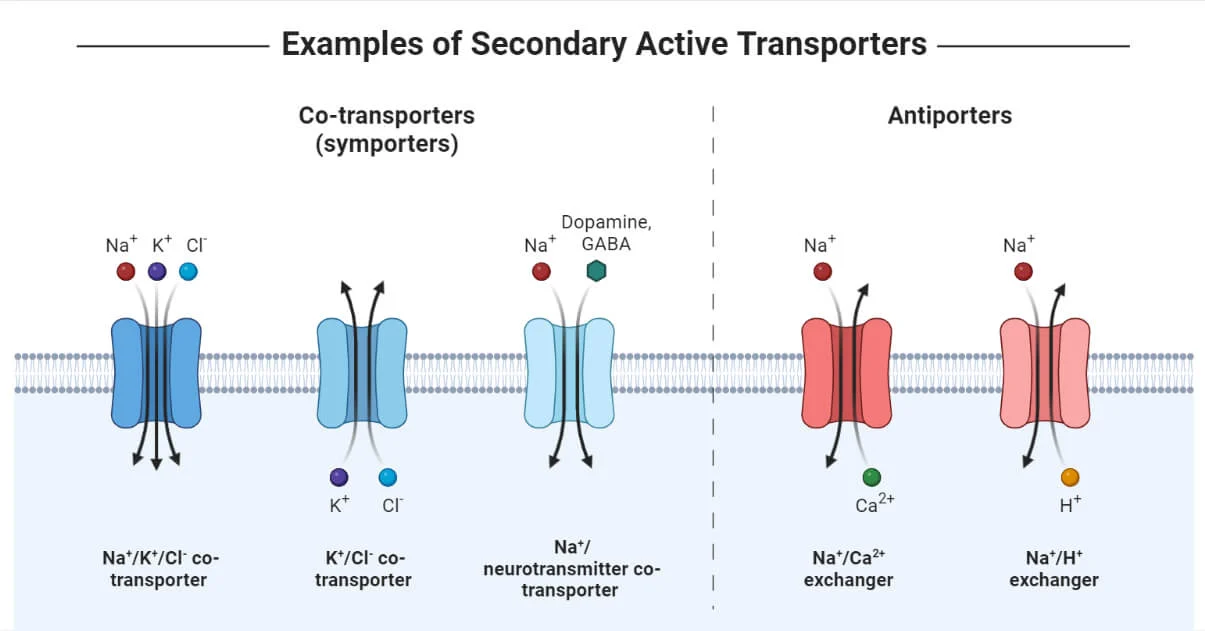
In the context of carrier-mediated transport, what is counter-transport?
Counter-transport: go opposite directions across membrane.
Facilitated difussion and active transport (passive and active mechanisms respectively) are examples of what type of transport?
carrier mediated transport
Facilitated diffusion across a membrane is when a substance moves down its concentration gradient. Energy is supplied by the concentration gradient. Is ATP needed?
No, the energy is supplied by the concentration gradient.
Facilitated diffusion across a membrane is when a substance moves down its concentration gradient. Energy is supplied by the concentration gradient, so no ATP is needed. However, what type of protein is required?
Transport protein. Different transport proteins for different substances.
How does facilitated diffusion differ from simple diffusion?
The maximum rate is dependent on the availability of transport protein because it can reach saturation.
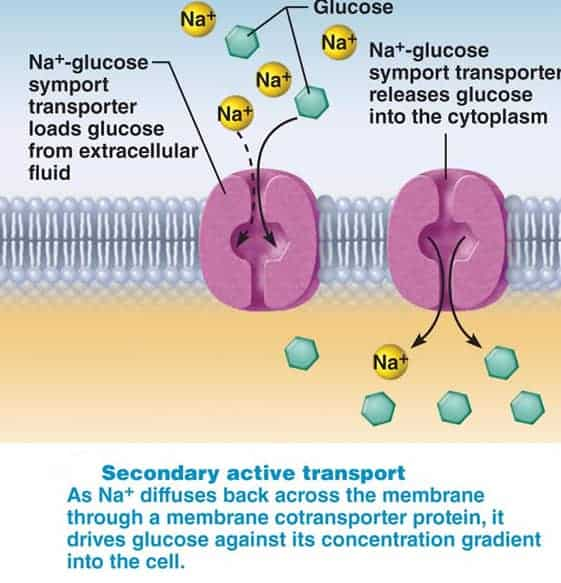
One substance moves down its concentration gradient while another substance moves against its concentration gradient. The energy is supplied by the concentration gradient of the substance moving down. This b**** moving against the concentration gradient hitched a ride on someone else’s ATP. This whole process requires a transport protein btw. What type of transport is this?
Facilitated diffusion with co-transport against the concentration gradient.
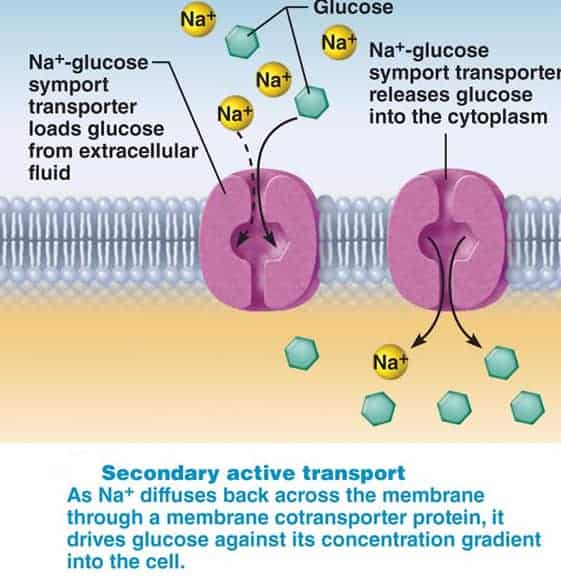
In your small intestine and kidney:
Na⁺ has a high concentration outside the cell and low inside.
→ It naturally moves down its gradient (into the cell).Glucose has a low concentration outside and high inside.
→ It shouldn’t move in naturally, but it does — because the transporter uses the energy from Na⁺ moving in.
So:
Na⁺ = downhill (provides energy)
Glucose = uphill (gets energy)
What type of transport does this describe?
Facilitated diffusion with co-transport against the concentration gradient
Active transport across a membrane consumes ATP. This means it is independent of _____ ____.
concentration gradients.
Ion pumps and secondary active transport are examples of what type of transport?
active transport
Na+’s gradient powers the protein to help move glucose, so glucose is what is being moved by what type of transport?
secondary active transp
What is transmembrane potential?
The difference in electrical potential between inside and outside a cell.
At rest, cells have more (positive/negative) charge inside than outside. (resting membrane potential)
Negative
A high conc of Na+ moves into the cell. Does the cell get more positive or negative?
Positive
A high conc of Cl- moves into the cell. Does the cell get more positive or negative?
negative
A high conc of Ca2+ moves into the cell. Does the cell get more positive or negative?
Positive
A high conc of K+ moves out of the cell. Does the cell get more positive or negative?
Negative
What is the term for the sum of all forces of all chemical and electrical gradients acting across the cell membrane?
Electrochemical gradient
Sodium-potassium exchange pump stabilizes resting potential at what mV for nerve & muscle cells? (hint theyre different btw)
-70 mV in nerve cells
-85 mV in muscle cells
What is the Electrochemical gradient?
the sum of all forces of all chemical and electrical gradients acting across the cell membrane
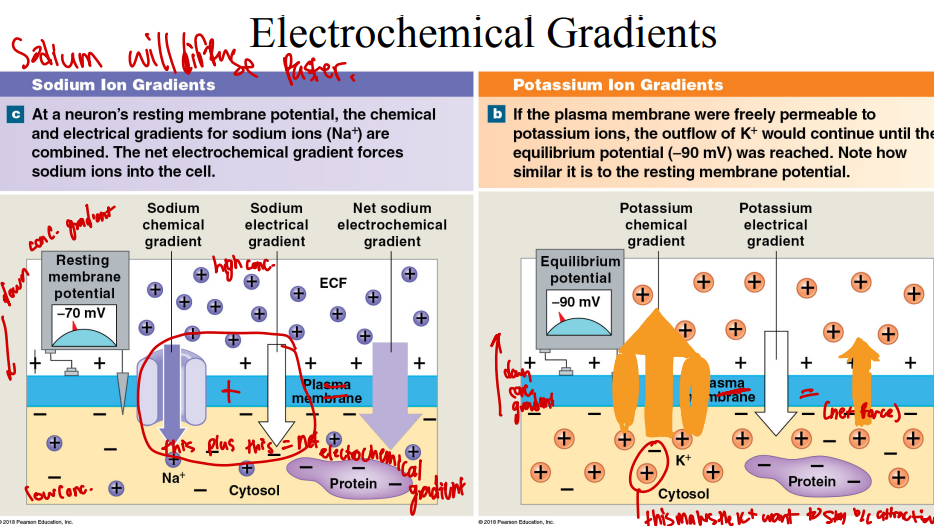
Sodium chemical gradient + sodium electrical gradient =
net electrochemical gradient.
Electrical gradients can either reinforce or oppose the chemical gradient for each ion. The ______ ____ for a specific ion is the sum of the chemical and electrical forces acting on that ion across the plasma membrane.
electrochemical gradient
Ion flow is a form of electrical current. Ions move across the membrane through protein channels. What is the driving force for this?
Diffusion along electro-chemical gradient (trans-membrane potential is equivalent of a battery)
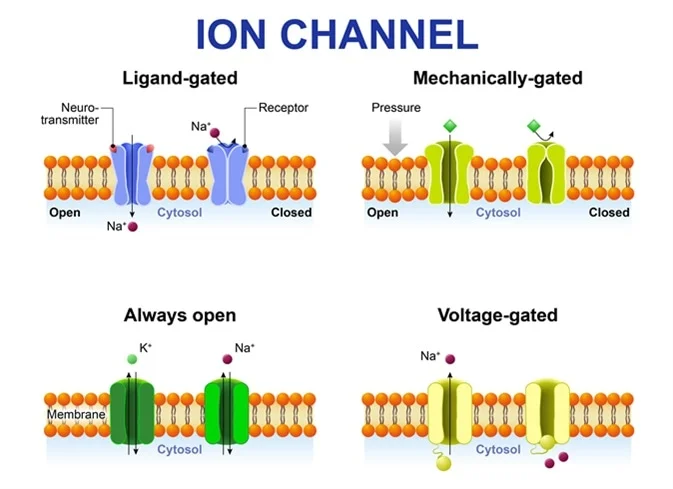
What are gated channels?
open in response to various stimuli
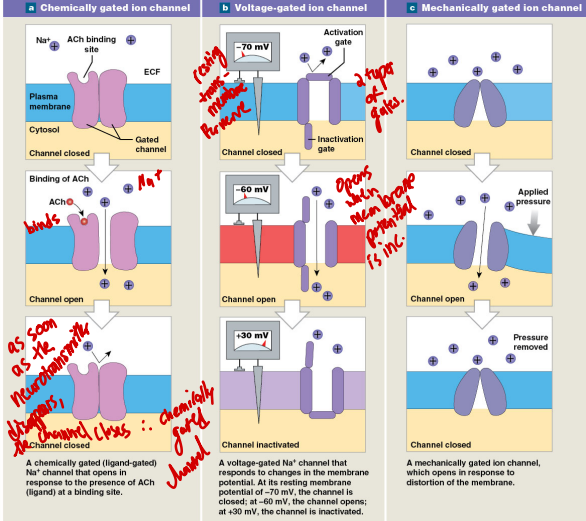
What are chemically regulated channels? aka: Chemically gated channels
Open or close when they bind specific chemicals
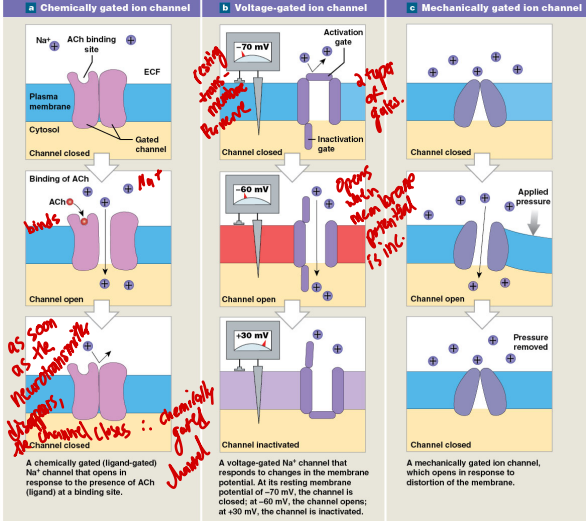
What are voltage regulated channels? aka: voltage gated channels
Open or close in response to level of trans-membrane potential
What is the neuromuscular junction?
The synpase between a nerve cell and muscle cell.
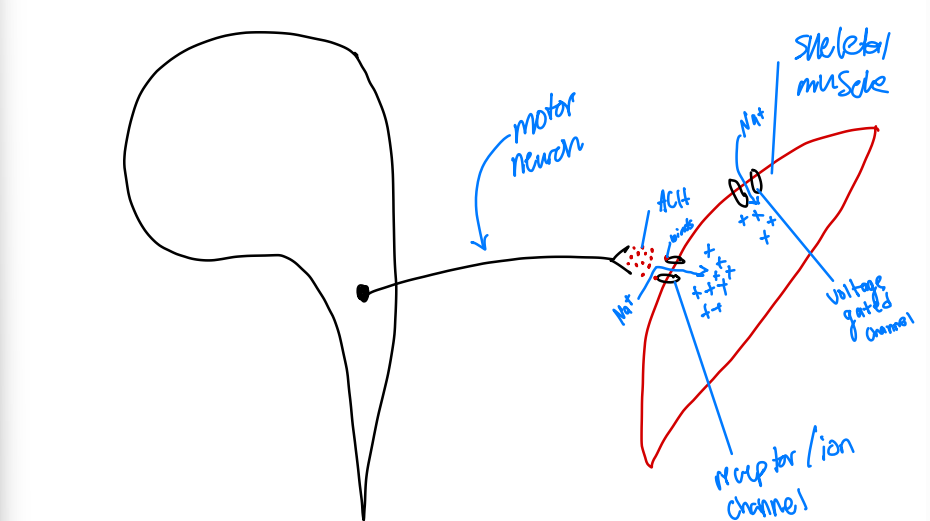
The Acetylcholine (ACh) gated sodium ion channel is an example of a chemically regulated gated channel.
Describe the process.
The nerve cell process releases acetylcholine by exocytosis, and then ACh binds to the receptor on the gated sodium channels in the muscle membrane, causing the sodium channel to open.
Voltage regulated gated channels are often found in excitable membranes. What are excitable membranes?
membranes capable of having action potentials
at resting membrane potential, most voltage regulated channels are closed.
T/F: Nerve cell membranes are excitable.
T
T/F: Nerve cell membranes are not excitable.
F, they are excitable
T/F: Cell membranes of muscle cells are excitable.
T
T/F: Cell membranes of muscle cells are NOT excitable.
F, they ARE excitable.
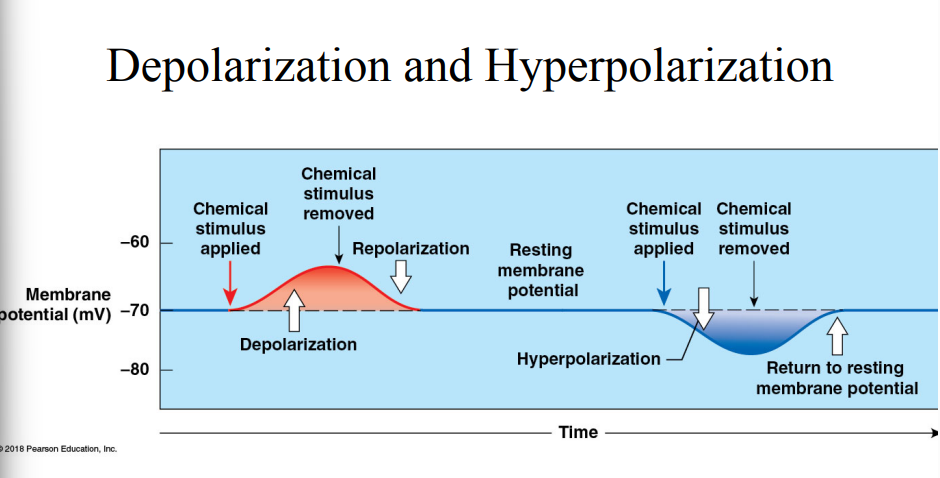
A change in the level of trans-membrane potential opens or closes voltage regulated ion channels. There are 3 types of polarization. What is depolarization?
Depolarization – trans-membrane potential becomes less negative (more positive)
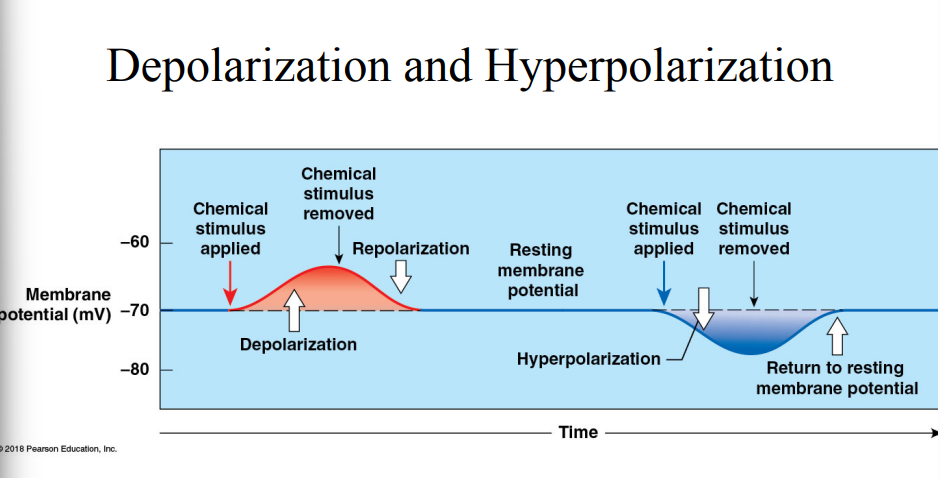
A change in the level of trans-membrane potential opens or closes voltage regulated ion channels. There are 3 types of polarization. What is hyperpolarization?
Hyperpolarization – trans-membrane potential becomes more negative (less positive)
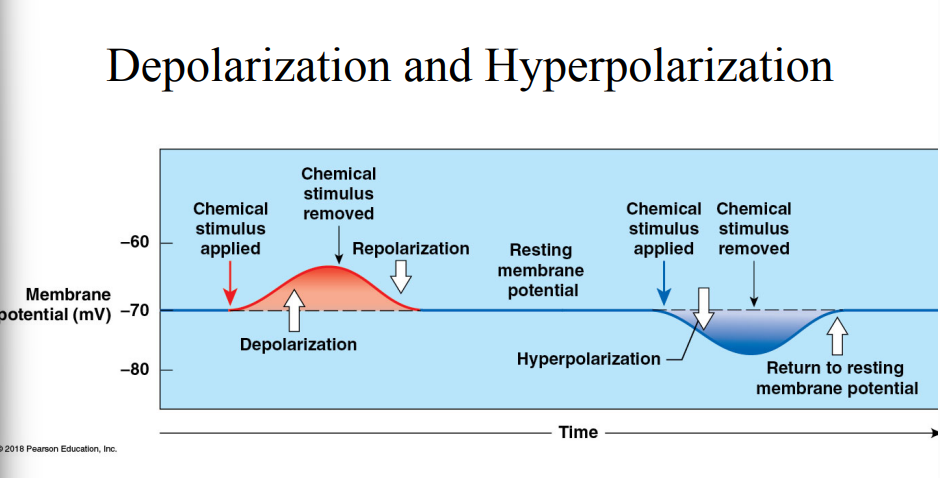
A change in the level of trans-membrane potential opens or closes voltage regulated ion channels. There are 3 types of polarization. What is repolarization?
Repolarization – trans-membrane potential returns toward resting potential after being depolarized
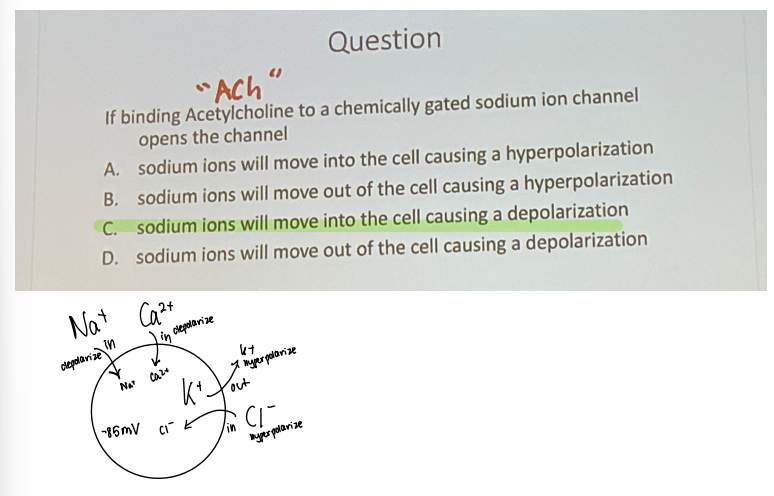
If binding acetylcholine to a chemically gated sodium ion channel opens the channel, sodium ions will move into the cell causing a _____ (depolarization or hyperpolarization)?
depolarization